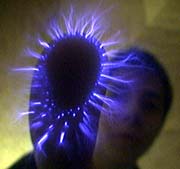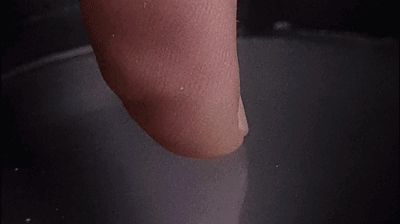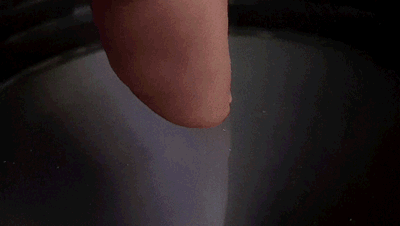Kirlian Effect
One of the most general and most universally used methods in science is so-called perturbation technique.
Response to a well chosen perturbation can reveal object properties that are not obvious when the perturbation is absent.
For example, if you need to know if a wall next to you is solid or hollow, all you need to do is to "knock" it gently and listen to its response. The response of the wall (the sound it emits) reveals the wall's internal properties.
Similar approach is used in science to investigate properties of extremely wide range of objects in all imaginable scientific disciplines: from physical, biological, Real World objects and systems to objects of purely hypothetical and imaginary nature such as mathematical models.
Kirlian Effect is a visible electro-photonic glow of an object (see the picture below) in response to pulsed electrical field excitation.

Electro-photonic Kirlian effect glow is visible to a naked eye. The photo shows a snapshot of the Kirlian glow around a human fingertip seen from underneath, through a semi-transparent glass electrode that provided an electrical field excitation.
The magnitude and duration of the excitation is adjusted to induce the avalanche effect in the ionized gas surrounding the object while providing minimal possible disturbance to the object. The avalanche effect amplifies the electro-photonic response of the object so that it can be observed as a visible glow. The effect has been observed by Nikola Tesla late in 19th century, but named after Semion Kirlian who investigated it since 1930s.
Much like a sound response of a wall to a gentle impact reveals the wall internal properties, the visible electro-photonic glow contains information about the object that was excited to glow.
In early days, Kirlian images were recorded on photographic emulsion. Since the sensitivity of a photographic emulsion varies greatly with environmental factors such as humidity and temperature, recordings were not reproducible. For this reason, some scientists dismissed the Kirlian effect as not very useful.
Modern GDV instruments developed by Prof Korotkov use glass electrodes and digital cameras so their recordings are reproducible in a wide range of environmental conditions.
Using reproducible recording techniques we can focus on the INFORMATION encoded in stimulated electro-photonic images.


Increasing the intensity of the electrical field stimulation provides spectacular views, but to maximize the diagnostic capability we need to minimize the perturbation